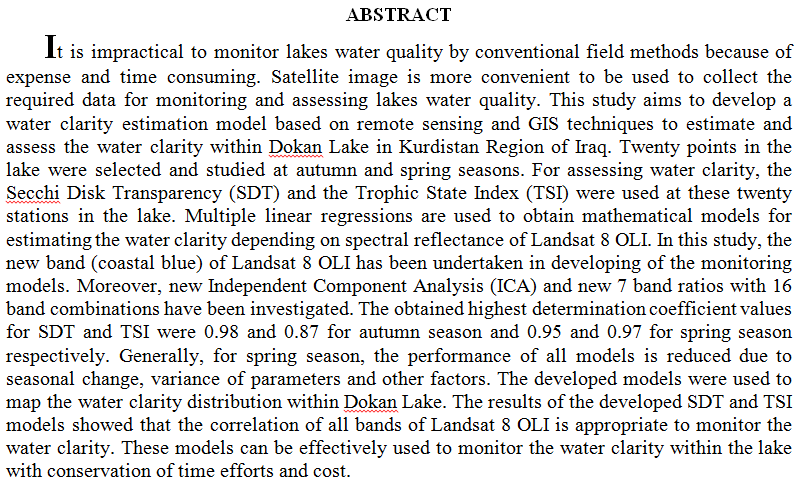
The study was carried out in plant tissue culture laboratory, University of Baghdad during the period 2017-2019, as factorial experiment in complete randomized design, to study the effect of PEG at (0, 2, 4, 6 and 8%) on physiological and chemical changes in callus of three sunflower (Ishaqi 1, Aqmar and Al-haga) induced by the cultivation of the young stem in vitro under water stress. The content of callus cells of SOD, POD, CAT and APX enzymes as well as content of hydrogen peroxide were determined as indicators to determine the effect of PEG in callus tissue cells cultivated on medium equipped with the PEG concentrations. The results showed that cultivars were differs significantly and Al-hajavariety was superior in increasing SOD to 24.
... Show More (3)
(3)
Dissolution of gypsum rock in water is significant, which may result in hydrocarbon reservoir formation and evaporate deposits. However, the complexity of the gypsum dissolution process is still of interest because of its uncleanness that requires more critical analysis. The objectives of this experimental study are emphasis on the dissolution characteristics of gypsum rock under room temperature and by various types of water; namely: deionized, tap, fresh, acidic, well, and normal rainwatre. In addition, the influences of dissolution on gypsum rock's mechanical and physical characteristics. Gypsum rock was obtained from Agjalar area, in the southwest of Sulaymaniyah city, Northern Iraq. Experimental results show that we
... Show More (2)
(2)
 (103)
(103)
 (94)
(94)
Previously, many empirical models have been used to predict corrosion rates under different CO2 corrosion parameters conditions. Most of these models did not predict the corrosion rate exactly, besides it determined effects of variables by holding some variables constant and changing the values of other variables to obtain the regression model. As a result the experiments will be large and cost too much. In this paper response surface methodology (RSM) was proposed to optimize the experiments and reduce the experimental running. The experiments studied effects of temperature (40 – 60 °C), pH (3-5), acetic acid (HAc) concentration (1000-3000 ppm) and rotation speed (1000-1500 rpm) on CO2 corrosion performance of t
... Show MoreThis study was carried out to investigate the possibility of chickpea soaked water as a substitute for yeast in dough fermentation and its effects on sensory properties of the laboratory loaf bread. Chickpea was soaked for 24,48 and 72 hours at room temperature and used in proportion with or without yeast in dough fermentation . The results revealed that , as the percentage of soaked chickpea water substitution increased, the volume of the produced loaf bread decreased as compared with the control treatment (only yeast ).Best results were obtained by using soaked chickpea water for 24 hours in proportion of 1:1 soaked chickpea water : yeast regarding the sensory properties ,volume and leavening of the loaf bread.
Keywords: chickpea so
Parasitological investigation of piscivorous birds in Al-Hammar marsh south of Iraq during December-February 2004 and December 2005 were revealed that water birds infected with five nematode species, which belong to three different superfamilies, Desmidocercella numidica (Seurat, 1920) (Superfamily: Aproctoidea) from three piscivorous birds including Grey heron Ardea cinerea, Bittern Botaurusstellaris, and small white heron Ardeola ralloides; Avioserpens sp. 1 and Avioserpens sp. 2 (Superfamily: Dracunculoidea) from small bittern Ixobrychus minutus and black glossy ibis Plegadisfalcinellus respectively; Baruscapillaria sp. and Baruscapillarinae gen. sp. (Sup
... Show MoreThe removal of turbidity from produced water by chemical coagulation/flocculation method using locally available coagulants was investigated. Aluminum sulfate (alum) is selected as a primary coagulant, while calcium hydroxide (lime) is used as a coagulant aid. The performance of these coagulants was studied through jar test by comparing turbidity removal at different coagulant/ coagulants aid ratio, coagulant dose, water pH, and sedimentation time. In addition, an attempt has been made to examine the relationship between turbidity (NTU) and total suspended solids (mg/L) on the same samples of produced water. The best conditions for turbidity removal can be obtained at 75% alum+25% lime coagulant at coagulant dose of 80 m
... Show MoreThe aim of present work is to study the removal of phenol present in aqueous feed solution by the emulsion liquid membrane technique using kerosene as a diluent, sodium hydroxide as a stripping agent, and sorbitan monooleate (Span 80) as a surfactant. The parameters studied were: surfactant concentration, volume ratio of membrane phase to internal phase, and stirring speed. It was found that more than 98% of phenol can be removed at the conditions were surfactant concentration 2% (v/v), volume ratio of membrane phase to internal phase 5:1 and stirring speed 400 rpm. Maximum phenol extraction efficiency at 7 minutes of process time was observed. It was found that there was a good agreement between the standard kerosene an
... Show More